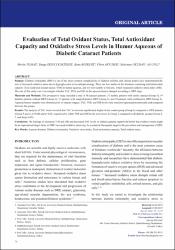| dc.contributor.author | Yılmaz, Mevlüt | |
| dc.contributor.author | Ekinci Koktekir, Bengu | |
| dc.contributor.author | Bozkurt, Banu | |
| dc.contributor.author | Akyürek, Fikret | |
| dc.contributor.author | Okudan, Suleyman | |
| dc.contributor.author | Ünlü, Ali | |
| dc.date.accessioned | 2023-03-23T13:16:02Z | |
| dc.date.available | 2023-03-23T13:16:02Z | |
| dc.date.issued | 2020 | en_US |
| dc.identifier.citation | Yılmaz, M., Köktekir, B. E., BOZKURT, B., Akyürek, F., Okudan, S., & Ünlü, A. (2020). Evaluation of Total Oxidant Status, Total Antioxidant Capacity and Oxidative Stress Levels in Humor Aqueous of Diabetic Cataract Patients. Journal of Retina-Vitreous, 29, 25-29. | en_US |
| dc.identifier.issn | 13001256 | |
| dc.identifier.uri | https://doi.org/10.37845/ret.vit.2020.29.5 | |
| dc.identifier.uri | https://hdl.handle.net/20.500.12513/4990 | |
| dc.description.abstract | Purpose: Diabetic retinopathy (DRP) is one of the most common complications of diabetes mellitus and various studies have demonstrated the role of increased oxidative stress due to hyperglycemia in its pathophysiology. There are few studies in the literature examining total antioxidant capacity (TAC) and total oxidant status (TOS) in humor aqueous, and we were unable to find any, which measured oxidative stress index (OSI). The aim of this study was to investigate whether TAC, TOS, and OSI in the aqueous humor changed according to DRP stage. Materials and Methods: This prospective study included a total of 86 cataract patients: 31 healthy patients with senile cataract (Group 1), 19 diabetic patients without DRP (Group 2), 17 patients with nonproliferative DRP (Group 3), and 19 patients with proliferative DRP (Group 4). Aqueous humor samples were obtained prior to cataract surgery. TAC, TOS, and OSI levels were measured spectrophotometrically and compared between the groups. Results: The analysis of TAC levels revealed that TAC levels were significantly higher in the control group (Group 1) compared to DRP patients (Group 3 and 4, p=0.042 and p=0.02, respectively), while TOS and OSI levels were lower in Group 1 compared to all diabetic groups (Group 2, 3, and 4) (p<0.05). Conclusion: The findings of increased TOS and OSI and decreased TAC levels in diabetic patients support the belief that oxidative stress might be an important etiologic factor in DRP. Increased oxidative stress may be a potential therapeutic target in the prevention and management of DRP. © 2020 Gazi Eye Foundation. All rights reserved. | en_US |
| dc.language.iso | eng | en_US |
| dc.publisher | Gazi Eye Foundation | en_US |
| dc.relation.isversionof | 10.37845/ret.vit.2020.29.5 | en_US |
| dc.rights | info:eu-repo/semantics/openAccess | en_US |
| dc.subject | Aqueous humour | en_US |
| dc.subject | Diabetic retinopathy | en_US |
| dc.subject | Oxidative stress index | en_US |
| dc.subject | Total antioxidant capacity | en_US |
| dc.subject | Total oxidant status | en_US |
| dc.title | Evaluation of total oxidant status, total antioxidant capacity and oxidative stress levels in humor aqueous of diabetic cataract patients | en_US |
| dc.type | article | en_US |
| dc.relation.journal | Retina-Vitreus | en_US |
| dc.contributor.department | Sağlık Yüksekokulu | en_US |
| dc.contributor.authorID | Mevlüt Yılmaz / 0000-0001-7896-7279 | en_US |
| dc.identifier.volume | 29 | en_US |
| dc.identifier.issue | 1 | en_US |
| dc.identifier.startpage | 25 | en_US |
| dc.identifier.endpage | 29 | en_US |
| dc.relation.publicationcategory | Makale - Uluslararası Hakemli Dergi - Kurum Öğretim Elemanı | en_US |


















